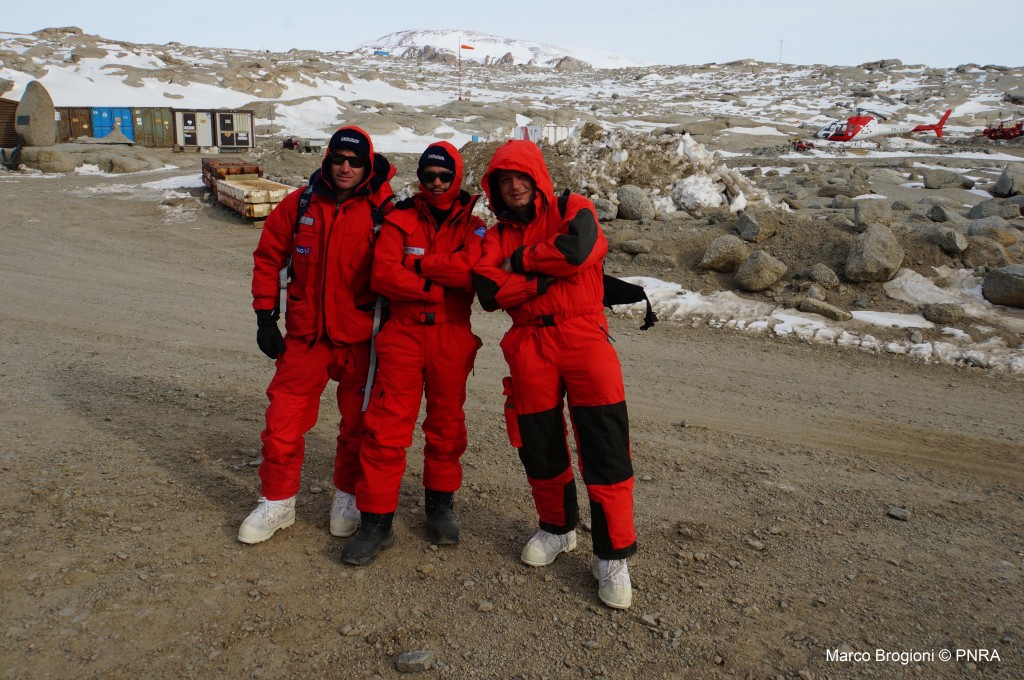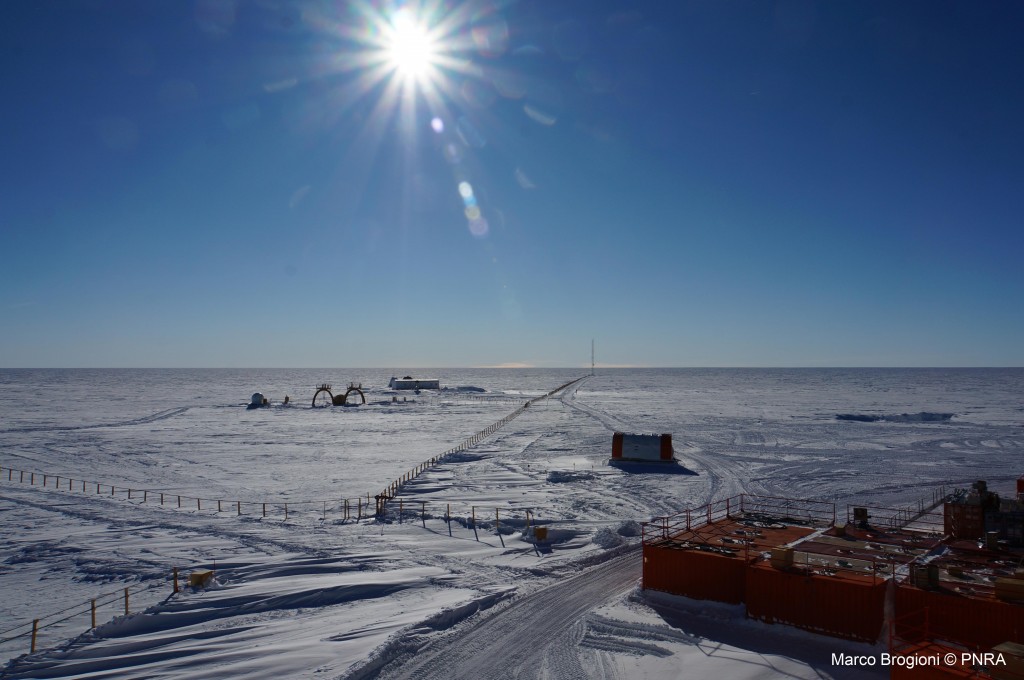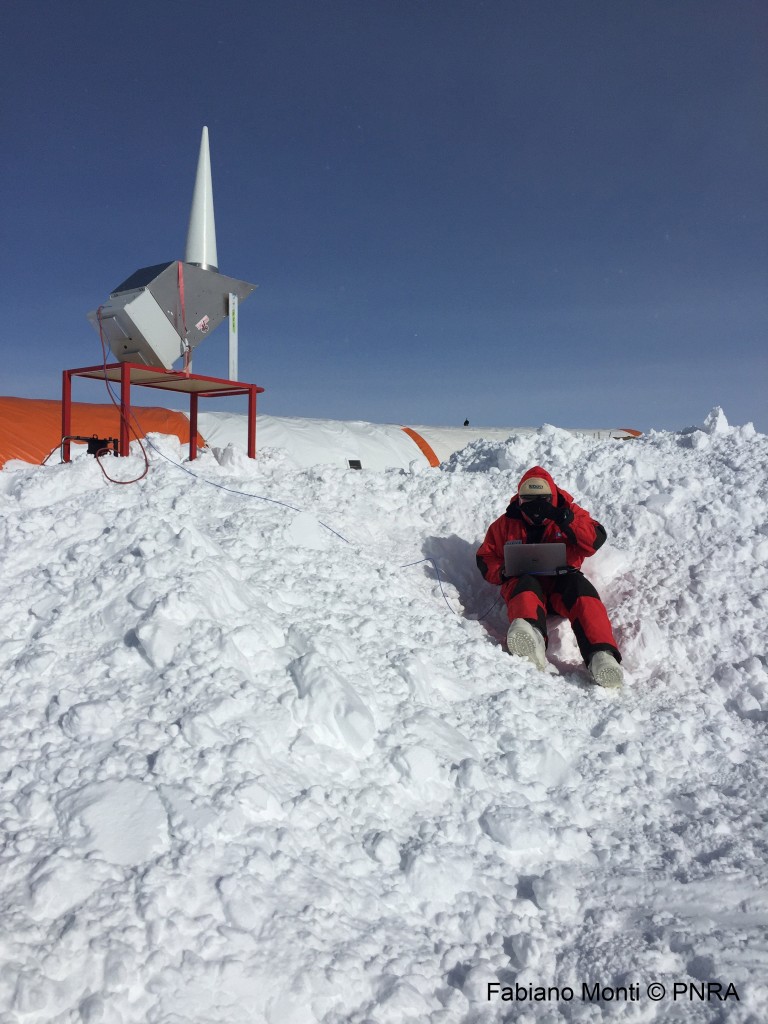Post from Marco Brogioni (IFAC) and Fabiano Monti (Insubria University)
It’s been two years since the last DOMEX campaign at Dome-C in Antarctica, where the Italian-French station of Concordia is located, but we’re here again to support ESA’s SMOS mission.
DOMEX is a campaign to build up a collection of a well-calibrated, multiyear, time series of L-band brightness temperature measurements and infrared brightness temperature over four years.

Waiting at the Mario Zucchelli Station to fly to Dome-C: Fabiano, Stefano & Marco. (Credits DOMEX team)
These data are compared with those from SMOS to verify that the satellite instrument is calibrated. Moreover, during this year’s campaign a GNNS reflectometer will be installed at the same site within the framework of another ESA project (GRAIS). This project involves collecting data over one year that will be compared to radiometric data to derive properties of ice sheet structure.
The experiment, led by the Institute of Applied Physics ‘Nello Carrara’ (PI Giovanni Macelloni), is conducted in cooperation to University of Insubria–Italy , INGV (National Institution of Geophysics and Volcanology)–Italy and IEEC (Institute of Space Studies of Catalonia)–Spain. It is supported by ESA and by the Italian Programme of National Research in Antarctica (PNRA).
This year, the experiment crew includes Marco Brogioni (IFAC) and Fabiano Monti (Insubria University). Below is the first report from the field!
So, here we are back in Antarctica. This is the second time for both of us: Marco and Fabiano, but the first time together.
Marco works for the IFAC-CNR of Florence (smart guys looking at the snow emission at L-band in support of the SMOS mission) and Fabiano for the Insubria University, a snow scientist (ski instructor specialised in digging snow pits, actually a happy snow scientist).

Landscape around Dome-C from the Concordia Base. The American tower with DOMEX is in the background. (Credits: DOMEX team)
The goal of our mission here is to measure ice sheet properties with several microwave instruments (the DOMEX radiometer, a GOLD-RTR and PIR GNSS-R provided by ICE-IEEC and UWBRAD radiometer provided by Ohio State University) and by means of ground measurements (with NIR pictures, dielectric density measurements and classic snow pits).
Here is spring time, but the autumn in the Alps was much better!
It is very common to hear scientists say that there is no wind at the Concordia base, but let us tell you that through all of last week there were 4–6 m/s wind. We realise, in other places this is common, but here at –45°C it means the wind-chill temperature is around –60°C … and this is tough for working outside.
The plan for our first week was to get used to the altitude (here the feeling is the same as being at 3700–4000 m in the Alps), to put together and test both the instruments and the set up for the snow measurements.
Everything worked fine, so we are now ready to install and start using the instruments, and also to perform the first snow measurements.
However, it is now Sunday evening so time to enjoy a great meal at the best restaurant on the continent…
Talk soon,
Marco and Fabiano









Discussion: 2 comments
Hi Marco, great to hear from you and colleagues that everthing is working fine at Antarctica! Just to let you know that since today the news you posted to this blog are directly linked on the homepage of our Institute of Applied Physics (https://www.ifac.cnr.it/). Please keep us posted for future updates and Best Wishes from your friends in Florence.
Roberto
Hi Marco and Fabiano – great that you arrived at Dome-C safely. We are looking forward to your progress updates on refurbishment of the RADOMEX instrument for SMOS Validation, and installation of the ICE-IEEC GNSS-R and OSU UWBRAD instruments. Best wishes from ESA colleagues in NL! Stay warm and in one piece.
Mark Drinkwater